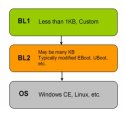Datalight sheds light on NAND flash
Jun 27, 2006 — by LinuxDevices Staff — from the LinuxDevices Archive — views With rising density and falling prices, NAND flash memory is finding its way into an increasing number of portable devices, including MP3 players, mobile phones, and digital cameras. Yet, NAND technology has inherent constraints that must be understood in order to use it successfully.
With rising density and falling prices, NAND flash memory is finding its way into an increasing number of portable devices, including MP3 players, mobile phones, and digital cameras. Yet, NAND technology has inherent constraints that must be understood in order to use it successfully.
A pair of tech notes from Datalight, a specialist in flash file system software, offers insight into some key NAND flash issues:
- An overview of NAND flash memory controllers — This tech note describes some of the limitations of NAND technology and shows how NAND controllers, either integrated with a processor or in the form of a separate device, address these problems to improve performance and ease integration. In turn, NAND controllers require specialized software to hide the “unpleasant” details and present a usable interface.
- Leveraging processor-supplied SRAM to facilitate OneNAND bootloaders — This tech note discusses the problems of booting a processor from NAND flash. The 1 KB bootRAM buffer included in Samsung's OneNAND devices is useful, but hardly enough. Author Timothy Johns explains the boot process in general, and shows how to use the SRAM built into many mobile processors to create a functional boot loader.
This article was originally published on LinuxDevices.com and has been donated to the open source community by QuinStreet Inc. Please visit LinuxToday.com for up-to-date news and articles about Linux and open source.